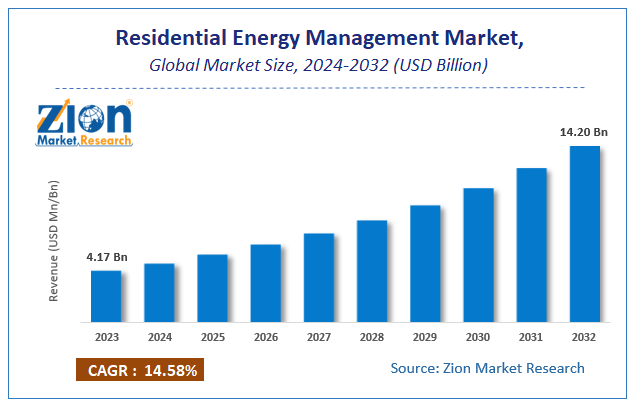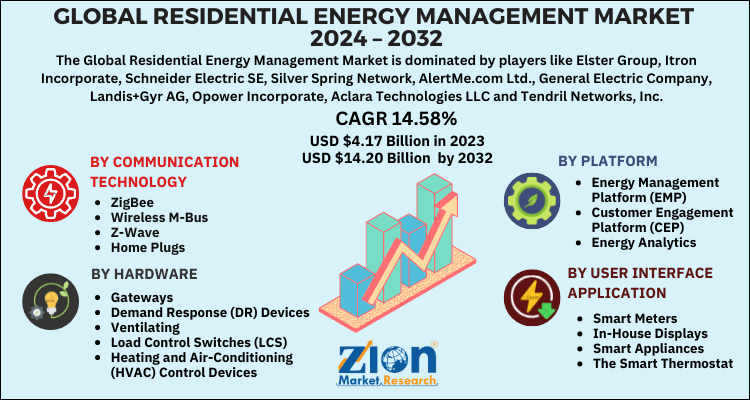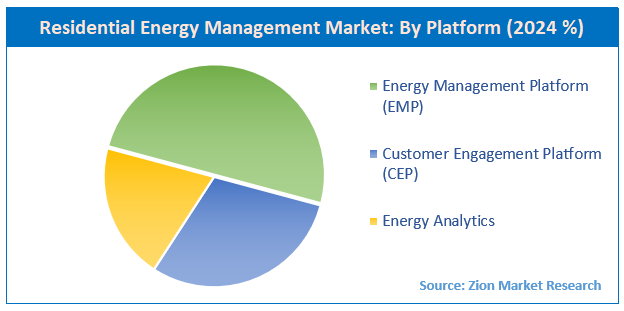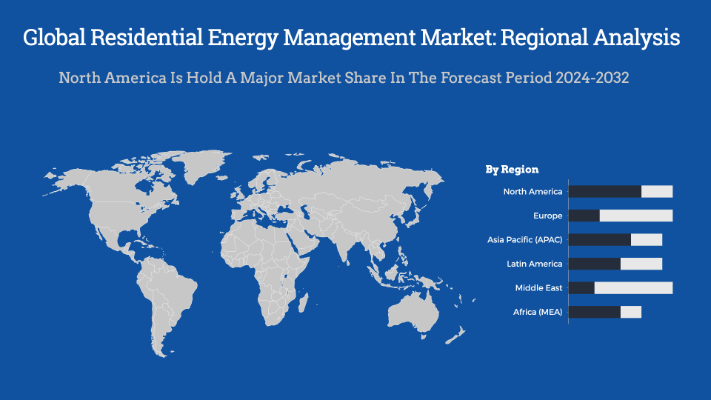Residential Energy Management Market Size & Share Analysis 2032

Residential Energy Management Market By Platform (Energy Management Platform (EMP), Customer Engagement Platform (CEP) and Energy Analytics), By User Interface Application (Smart Meters, In-House Displays, Smart Appliances, and The Smart Thermostat), By Communication Technology (ZigBee, Wireless M-Bus, Threads, Wi-Fi, Z-Wave, and Home Plugs), By Hardware (Gateways, Demand Response (DR) Devices, Ventilating, Load Control Switches (LCS), Heating and Air-Conditioning (HVAC) Control Devices), and By Region: Global Industry Analysis, Size, Share, Growth, Trends, and Forecast, 2024-2032
| Market Size in 2023 | Market Forecast in 2032 | CAGR (in %) | Base Year |
|---|---|---|---|
| USD 4.17 Billion | USD 14.20 Billion | 14.58% | 2023 |
Description
Global Residential Energy Management Market: Insights
According to the report published by Zion Market Research, the global Residential Energy Management Market size was valued at USD 4.17 Billion in 2023 and is predicted to reach USD 14.20 Billion by the end of 2032. The market is expected to grow with a CAGR of 14.58% during the forecast period. The report analyzes the global Residential Energy Management Market's growth drivers, restraints, and impact on demand during the forecast period. It will also help navigate and explore the rising opportunities in the Residential Energy Management industry.
Key Insights
- As per the analysis shared by our research analyst, the global Residential Energy Management Market is estimated to grow annually at a CAGR of around 14.58% over the forecast period (2024-2032).
- In terms of revenue, the global Residential Energy Management Market size was valued at around USD 4.17 Billion in 2023 and is projected to reach USD 14.20 Billion by 2032.
- Based on the platform, The Energy Management Platform (EMP) segment leads the REM market. Its dominance is attributed to its capability to manage power supply effectively by communicating with household appliances and utilities, monitoring energy usage, and providing information to reduce power consumption through scheduling. This functionality has led to widespread adoption in residential settings.
- Based on the user interface application, Smart meters are the most dominant segment in the user interface application category. Their prevalence is due to the increasing demand for electricity and the emergence of smart grids, which offer new opportunities for residential energy management by enabling real-time energy consumption tracking and cost-saving solutions.
- Based on the communication technology, ZigBee holds the largest market share in communication technology for REM systems. Its popularity stems from rising concerns about energy management and its provision of easy-to-use wireless home area networks (HANs) for managing energy.
- Based on the hardware, The hardware segment dominates the REM market, accounting for over 60% of the market share. This is due to the essential role hardware components play in enabling real-time data acquisition, communication, and control of energy-consuming devices within a home, facilitating intelligent energy management.
- Based on the region, America is the leading region in the REM market, contributing approximately 35% of the total revenue. This dominance is driven by the high adoption of smart energy solutions and government initiatives promoting energy efficiency. However, the Asia Pacific region is the fastest-growing, expected to expand at a CAGR of 18%, fueled by increasing urbanization, government incentives, and growing demand for energy-efficient solutions in countries like China and India.
Global Residential Energy Management Market: Overview
The residential energy management solutions are designed to provide a solution to the demand for a reduction in the consumption of energy by residential consumers. This latest development in the technology is very effective. With the help of residential energy management solutions, the utilization of power is very less which results in lower utility bills. To gain maximum savings, the residential energy management solutions measure the energy consumed by the home’s cooling, heating, individual appliances and lighting systems. The residential energy management solutions can be chosen independently or sometimes device control and data ownership rights are assigned to Energy Management Service Providers (EMSPs).
Global Residential Energy Management Market: Growth Factors
The key solutions that are available in the residential energy management market are lighting controls, HVAC controllers, programmable thermostats and self-monitoring systems. The wide applications of these solutions in the different sectors are driving market growth. The most targeted areas in the residential sector to manage energy consumption are space heating and cooling and water heating which consumes the maximum energy, thus residential energy management is utilized. The traditional residential power industry is being now replaced by solar PV panels.
The recent trend in residential energy management is communicating thermostat solution which provides a solution for the consumption of energy by two-way communication between the energy office/company and the home. In this provision, the energy company can monitor and adjust the temperature settings. All these factors are acting favorable to the market growth. The vital role is played by the government in the growth of residential energy management solutions.
Recent Developments
- In August 2022, Enphase acquired GreenCom Networks to expand its home-energy software footprint in Europe.
- In December 2022, NRG acquired Vivint Smart Home in a strategic move into the consumer smart-home and distributed energy services market.
- In January 2025, ABB acquired Lumin to expand its residential energy management capabilities in North America.
- In August 2025, Schneider Electric acquired WattBuy, a home electrification software company, to strengthen its end-to-end home electrification offerings.
- In December 2021, Generac expanded its intelligent home energy ecosystem by acquiring ecobee, a leader in residential smart thermostats and energy management solutions.
- In December 2024, Homey (LG-owned) introduced the Energy Management Feature + Dongle, a new hardware/software solution designed to monitor smart devices, EV charging, and solar generation, connecting to smart meters in Europe.
Global Residential Energy Management Market: Report Scope
| Report Attributes | Report Details |
|---|---|
| Report Name | Residential Energy Management Market |
| Market Size in 2023 | USD 4.17 Billion |
| Market Forecast in 2032 | USD 14.20 Billion |
| Growth Rate | CAGR of 14.58% |
| Number of Pages | 193 |
| Key Companies Covered | Elster Group, Itron Incorporate, Schneider Electric SE, Silver Spring Network, AlertMe.com Ltd., General Electric Company, Landis+Gyr AG, Opower Incorporate, Aclara Technologies LLC and Tendril Networks, Inc |
| Segments Covered | By Platform, By User Interface Application, By Communication Technology, By Hardware, and By Region |
| Regions Covered | North America, Europe, Asia Pacific (APAC), Latin America, Middle East, and Africa (MEA) |
| Base Year | 2023 |
| Historical Year | 2018 to 2022 |
| Forecast Year | 2024 - 2032 |
| Customization Scope | Avail customized purchase options to meet your exact research needs. Request For Customization |
Global Residential Energy Management Market: Segmentation
The global residential energy management market is segmented globally on the basis of a platform, user interface application, communication technology, hardware, and regions. All the segments have been analyzed based on present and future trends and the market is estimated from 2024 to 2032.
On the basis of the Platform, the market is segregated into energy management platform (EMP), customer engagement platform (CEP) and energy analytics.
Based on the User Interface Application, the global market is classified as smart meters, in-house displays, smart appliances and smart thermostats.
In terms of communication Technology, the residential energy management market is divided into ZigBee, wireless M-Bus, threads, Wi-Fi, Z-Wave and home plugs.
Based on the Hardware, the market is segmented into gateways, demand response (DR) devices, ventilating, load control switches (LCS), and heating and air-conditioning (HVAC) control devices.
The Regional segment includes the current and forecast demand for North America, Europe, Asia Pacific, Latin America, and the Middle East and Africa.
Residential Energy Management Market Dynamics:
Key growth drivers
The Residential Energy Management (REM) market is primarily driven by the rising cost of energy and growing consumer awareness of sustainability and environmental issues. As electricity tariffs increase, homeowners are actively seeking ways to reduce consumption and lower their utility bills. The increasing adoption of smart home devices and the Internet of Things (IoT), such as smart thermostats, lighting, and appliances, provides a foundation for REM systems to monitor and control energy usage. Additionally, supportive government incentives, regulations, and tax credits that promote energy efficiency and the integration of renewable energy sources, like rooftop solar panels and battery storage, are accelerating the market's growth.
Restraints
Despite the strong growth drivers, the REM market faces several key restraints. A major hurdle is the high initial investment cost associated with purchasing and installing the necessary hardware and software. This can be particularly prohibitive for homeowners with middle or low incomes. Furthermore, consumer trust and privacy concerns are a significant barrier, as these systems collect sensitive data on household energy usage patterns. The lack of standardized communication protocols and interoperability among different vendors' devices creates a fragmented ecosystem, which can complicate system setup and deter potential users.
Opportunities
The REM market is presented with numerous opportunities for innovation and expansion. The increasing focus on integrating distributed energy resources, such as solar PV systems and electric vehicle (EV) chargers, provides a major opportunity for REM systems to act as a central hub for managing and optimizing a home's energy flow. The development of advanced software, leveraging Artificial Intelligence (AI) and Machine Learning (ML), can enable predictive analytics and automated energy optimization, leading to greater efficiency without sacrificing comfort. Furthermore, expanding into new construction projects, where REM systems can be integrated from the ground up, offers a significant growth avenue compared to the more complex process of retrofitting existing homes.
Challenges
The market is also confronted with a number of challenges that must be addressed for sustained growth. A significant challenge is the lack of consumer awareness and understanding of the benefits and complexities of REM systems. Many homeowners are not fully aware of how these systems can save them money or reduce their environmental impact. The fragmented nature of the market and the lack of a unified, user-friendly ecosystem can also be a challenge, requiring continuous support and education to ensure a positive user experience. Finally, cybersecurity vulnerabilities in a connected home environment pose a constant threat, and ensuring the reliability and security of REM systems is critical to gaining and maintaining consumer trust.
Global Residential Energy Management Market: Regional Analysis
A majority of the market growth in residential energy management can be seen in the North American and European regions. The factors that are acting favorable for this growth are the stringent government policies and the economic incentives. In order to expand their global presence, the manufacturers are seeking residential energy management solutions. Europe is adopting the smart meters technology and China is adopting the smart grid technology to consume energy economically.
Global Residential Energy Management Market: Competitive Players
The key market players in the residential energy management market include;
- Elster Group
- Itron Incorporate
- Schneider Electric SE
- Silver Spring Network
- AlertMe.com Ltd.
- General Electric Company
- Landis+Gyr AG
- Opower Incorporate
- Aclara Technologies LLC
- Tendril Networks, Inc.
Global Residential Energy Management Market: Segmentation
The global residential energy management market is segmented as follows;
By Platform
- Energy Management Platform (EMP)
- Customer Engagement Platform (CEP)
- Energy Analytics
By User Interface Application
- Smart Meters
- In-House Displays
- Smart Appliances
- The Smart Thermostat
By Communication Technology
- ZigBee
- Wireless M-Bus
- Threads
- Wi-Fi
- Z-Wave
- Home Plugs
By Hardware
- Gateways
- Demand Response (DR) Devices
- Ventilating
- Load Control Switches (LCS)
- Heating and Air-Conditioning (HVAC) Control Devices
Global Residential Energy Management Market: Regional Segments
- North America
- U.S.
- Europe
- UK
- France
- Germany
- Asia Pacific
- China
- Japan
- India
- Latin America
- Brazil
- The Middle East and Africa
What Report Provide
- Full in-depth analysis of the parent market
- Important changes in market dynamics
- Segmentation details of the market
- Former, ongoing, and projected market analysis in terms of volume and value
- Assessment of niche industry developments
- Market share analysis
- Key strategies of major players
- Emerging segments and regional markets
- Testimonials to companies in order to fortify their foothold in the market.
Table Of Content
FrequentlyAsked Questions
Residential Energy Management (REM) is the practice of monitoring and controlling energy consumption within a home. It involves using technology and data to optimize energy usage, reduce costs, and minimize environmental impact. REMS (Residential Energy Management Systems) typically include smart devices, sensors, and software to analyze energy consumption patterns and suggest ways to reduce waste.
According to a study, the global residential energy management market size was worth around USD 4.17 billion in 2023 and is expected to reach USD 14.20 billion by 2032.
The global residential energy management market is expected to grow at a CAGR of 14.58% during the forecast period.
North America is expected to dominate the residential energy management market over the forecast period.
Leading players in the global residential energy management market include Elster Group, Itron Incorporate, Schneider Electric SE, Silver Spring Network, AlertMe.com Ltd., General Electric Company, Landis+Gyr AG, Opower Incorporate, Aclara Technologies LLC and Tendril Networks, Inc, among others.
The residential energy management market report covers the geographical market along with a comprehensive competitive landscape analysis. It also includes cash flow analysis, profit ratio analysis, market basket analysis, market attractiveness analysis, sentiment analysis, PESTLE analysis, trend analysis, SWOT analysis, trade area analysis, demand & supply analysis, Porter’s five forces analysis, and value chain analysis.
HappyClients
Zion Market Research
Tel: +1 (302) 444-0166
USA/Canada Toll Free No.+1 (855) 465-4651
3rd Floor,
Mrunal Paradise, Opp Maharaja Hotel,
Pimple Gurav, Pune 411061,
Maharashtra, India
Phone No +91 7768 006 007, +91 7768 006 008
US OFFICE NO +1 (302) 444-0166
US/CAN TOLL FREE +1 (855) 465-4651
Email: sales@zionmarketresearch.com
We have secured system to process your transaction.
Our support available to help you 24 hours a day, five days a week.
Monday - Friday: 9AM - 6PM
Saturday - Sunday: Closed








